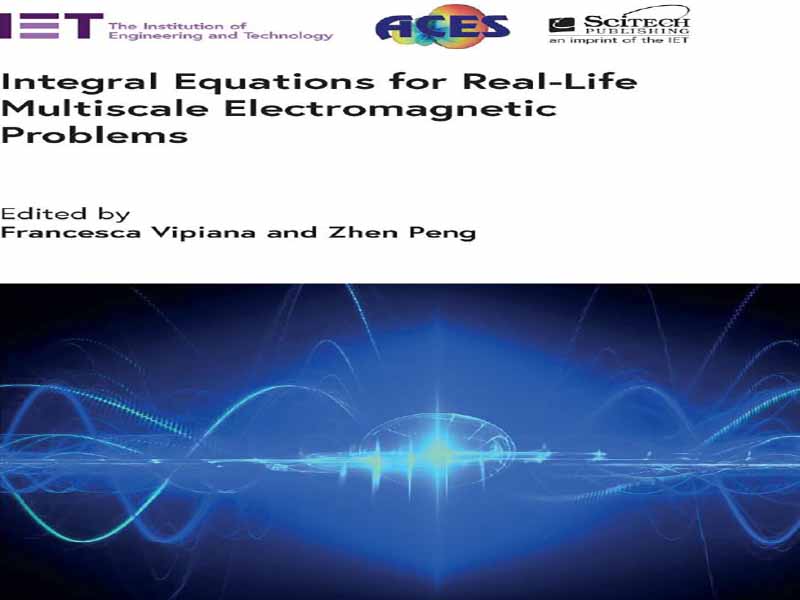- عنوان کتاب: Integral Equations for Real-Life Multiscale Electromagnetic Problems
- نویسنده: Francesca Vipiana
- حوزه: الکترومغناطیس
- سال انتشار: 2024
- تعداد صفحه: 398
- زبان اصلی: انگلیسی
- نوع فایل: pdf
- حجم فایل: 5.12 مگابایت
در زمینه الکترومغناطیس محاسباتی (CEM)، تکنیکهای معادله انتگرال سطحی (SIE) مبتنی بر روش گشتاورها (MoM) [1] ابزاری قدرتمند ارائه میدهند که برای شبیهسازی و مهندسی طیف متنوعی از کاربردها ضروری شده است. این کاربردها شامل طراحی آنتن پیشرفته [2،3]، سطح مقطع رادار (RCS) [4]، فناوریهای پنهانکاری [5]، سازگاری و تداخل الکترومغناطیسی (EMC/EMI) [6] و کاربردهای علوم نانو [7] و موارد دیگر میشود. روشهای SIE به ویژه هنگام برخورد با مسائل تابش و پراکندگی در مقیاس بزرگ جذاب هستند. برخلاف رویکردهای حجمی که نیاز به توصیف ساختارهای سهبعدی (3D) و فضای تعبیه دارند، روشهای SIE فقط پارامتری کردن سطوح مرزی دوبعدی (2D) را ضروری میسازند. اگرچه آنها منجر به سیستمهای ماتریسی متراکم و گسترده برای مسائل در مقیاس بزرگ میشوند، استفاده از حلکنندههای سریع تکراری، مانند الگوریتم چندقطبی سریع چندسطحی (MLFMA) [8،9]، امکان حل کارآمد چنین مسائلی را فراهم میکند. هدف این کتاب «معادلات انتگرالی برای مسائل الکترومغناطیسی چندمقیاسی واقعی» جمعآوری و توصیف رویکردهای اصلی اخیر موجود برای حل عددی معادلات انتگرالی زمانی (SIE) برای تحلیل مسائل الکترومغناطیسی چندمقیاسی واقعی است. در CEM، فرمولبندیهای مبتنی بر معادلات انتگرالی زمانی (SIE) در حال حاضر بیشترین کاربرد را برای تحلیل ساختارهای الکتریکی بزرگ و پیچیده دارند. با این حال، داشتن تکنیکهای پیشرفته برای حل آنها به روشی کارآمد و دقیق ضروری است. این کتاب در هفت فصل علمی سازماندهی شده است که با فصلهای «مقدمه» و «نتیجهگیری و دیدگاهها» تکمیل میشود. فصل 2 «فرمولبندیهای معادلات انتگرالی سطحی»، نوشته دونالد آر. ویلتون و ویلیام ای. جانسون، شامل مروری مختصر بر مفاهیم اساسی مورد نیاز برای درک، فرمولبندی و پرداختن محاسباتی به معادلات انتگرالی زمانی (SIE) مورد مواجهه در حوزه الکترومغناطیسی است. با استفاده از این دانش، معادلات انتگرالی رایج مورد استفاده در مسائل هارمونیک زمانی، شامل مواد خطی، تکهای همگن و ایزوتروپیک، ایجاد میشوند. سپس، روشهای عددی به کار رفته برای حل این معادلات انتگرالی، از جمله تکنیکهایی برای ارزیابی دقیق انتگرالهای تکین و نزدیک به تکین که در این فرآیند ظاهر میشوند، ارائه شده است. دو فصل بعدی، فصل 3 «تکنیکهای فاکتورگیری سریع مبتنی بر هسته»، نوشته اوزگور ارگول، بهرام خلیچی و واکور بی. ارتورک، و فصل 4 «روشهای فاکتورگیری سریع مستقل از هسته برای مسائل الکترومغناطیسی چندمقیاسی»، نوشته منگمنگ لی و همکاران، هر دو به تکنیکهای فاکتورگیری سریع برای یک راهحل کارآمد و دقیق برای مسئله الکترومغناطیسی اختصاص داده شدهاند. فصل 3 روشهای مبتنی بر هسته را شرح میدهد، که در آن تأکید اصلی بر هسته اصلی مسئله است و استفاده از آن را برای مدیریت مؤثر تعاملات الکترومغناطیسی به شیوههای کارآمدتر و در عین حال حفظ عملکردهای عددی دقیق تنظیم میکند. به طور خاص، بر الگوریتم چندقطبی سریع چندسطحی (MLFMA) تمرکز دارد و تمام خواص و پیادهسازیهای ممکن آن را برای دستیابی به راهحلهای دقیق، کارآمد و پایدار برای مسائل چندمقیاسی تجزیه و تحلیل میکند. در عوض، فصل ۴ تکنیکهای مستقل از هسته را شرح میدهد که کاملاً جبری هستند و از ماهیت کمبود رتبه بلوکهای ماتریس کوپلینگ MoM که توسط دو گروه مجزا از توابع پایه که در فضا به خوبی از هم جدا شدهاند، بهره میبرند. با استفاده از روشهای فاکتورگیری رتبه پایین، میتوان ماتریس MoM را تقریب زد و ارزیابی سریع حاصلضربهای ماتریس-بردار را در راهحلهای تکراری یا حلکنندههای مستقیم سریع امکانپذیر ساخت. فصل ۵، با عنوان «روش تجزیه دامنه» و نوشته ویکتور مارتین، هونگ-وی گائو، دیهگو ام. سولیس، خوزه ام. تابوآدا و ژن پنگ، بر کاربرد روشهای تجزیه دامنه (DD) در حل مسائل موج الکترومغناطیسی هارمونیک زمانی مبتنی بر SIE تمرکز دارد. این روشها به دلیل ظرفیتشان در ارائه الگوریتمهای راهحل تکراری پیششرطشده کارآمد و مؤثر، و به دلیل ماهیت ذاتاً موازیشان که آنها را با توجه به روندهای فعلی در معماری کامپیوتر به ویژه جذاب میکند، بسیار مطلوب هستند. این فصل دو دسته از روشهای DD را ارائه میدهد. یک دسته از آخرین پیشرفتها در فرمولبندی گالرکین ناپیوسته (DG) مبتنی بر سطح استفاده میکند که در آن پیوستگی جریانها در مرزهای دامنه مستقیماً با استفاده از فرمولبندی جریمه داخلی DG اعمال میشود. در عوض، دسته دیگر از روشهای DD از رویکرد «گسست و اتصال» پیروی میکنند، که در آن شرایط انتقال در امتداد خطوط گسست بین زیردامنهها اعمال میشود. دو فصل بعدی، فصل 6 «پیششرطبندی چندوضوحی»، نوشته فرانچسکا ویپیانا، ویکتور مارتین و خوزه ام. تابوآدا، و فصل 7 «پیششرطبندیهای کالدرون برای معادلات انتگرال الکترومغناطیسی»، نوشته آدرین مرلینی، سیمون بی. آدریان، الکساندر دلی و فرانچسکو پی. آندریولی، هر دو به تکنیکهای پیششرطبندی اعمال شده بر روی ماتریس MoM اختصاص دارند تا…
In the context of computational electromagnetics (CEM), surface integral equation (SIE) techniques based on the method of moments (MoM) [1] offer a potent tool that has become essential for simulating and engineering a diverse range of applications. These applications encompass advanced antenna design [2,3], radar cross-section (RCS) [4], stealth technologies [5], electromagnetic compatibility and interference (EMC/EMI) [6], and nanoscience applications [7], among others. SIE methods are particularly attractive when dealing with large-scale radiation and scattering issues. Unlike volumetric approaches that require the characterization of three-dimensional (3D) structures and embedding space, SIE methods necessitate the parameterization of two-dimensional (2D) boundary surfaces only. Although they result in dense and extensive matrix systems for large-scale problems, the utilization of iterative fast solvers, such as the multilevel fast multipole algorithm (MLFMA) [8,9], enables efficient resolution of such problems. The scope of this book “Integral Equations for Real-Life Multiscale Electromagnetic Problems” is to collect and describe the main recent available approaches for the numerical solution of SIEs to analyze real-life multiscale electromagnetic problems. In CEM, formulations based on SIEs are currently the most used for the analysis of electrically large and complex structures. Still, it is essential to have available state-of-the-art techniques to solve them in an efficient and accurate way. The book is organized into seven scientific chapters, completed with the “Introduction” and “Conclusion and perspectives” chapters. Chapter 2 “Surface integral equation formulations,” authored by Donald R. Wilton andWilliamA. Johnson, encompasses a concise overviewof essential concepts required to comprehend, formulate, and computationally address SIEs encountered in the field of electromagnetics. Utilizing this knowledge, the prevalent integral equations employed in time-harmonic problems are established, involving linear, piecewise homogeneous, and isotropic materials. Then, numerical methods employed to solve these integral equations are presented, including techniques for accurately evaluating the singular and near-singular integrals that emerge in the process. The following two chapters, Chapter 3 “Kernel-based fast factorization techniques,” authored by Özgür Ergül, Bahram Khalichi, and Vakur B. Ertürk, and Chapter 4 “Kernel-independent fast factorization methods for multiscale electromagnetic problems,” authored by Mengmeng Li et al., are both dedicated to fast factorization techniques for an efficient and accurate solution to the electromagnetic problem. Chapter 3 describes kernel-based methods, where the primary emphasis lies on the underlying kernel of the problem, adjusting its utilization to effectively handle electromagnetic interactions in more efficient mannerswhile maintaining accurate numerical performances. In particular, it focuses on the multilevel fast multipole algorithm (MLFMA), analyzing all its properties and possible implementations to obtain accurate, efficient, and stable solutions to multi-scale problems. Instead, Chapter 4 describes kernel-independent techniques that are entirely algebraic and take advantage of the rank-deficient nature of MoM coupling matrix blocks, generated by two distinct groups of basic functions that are well separated in space. By employing lowrank factorization methods, the MoM matrix can be approximated, enabling swift evaluations of matrix–vector products in iterative solutions or rapid direct solvers. Chapter 5, entitled “Domain decomposition method” and authored by Víctor Martín, Hong-Wei Gao, Diego M. Solís, José M. Taboada, and Zhen Peng, focuses on the application of domain decomposition (DD) methods in solving time-harmonic electromagnetic wave problems based on SIE. These methods are highly desirable due to their capacity to yield efficient and effective preconditioned iterative solution algorithms, and to their inherently parallel nature that makes them particularly attractive, according to the current trends in computer architecture. The chapter presents two classes of DD methods. One class utilizes the latest developments in the surfacebased discontinuous Galerkin (DG) formulation where the continuity of currents at domain boundaries is directly enforced by employing an interior penalty DG formulation. Instead, the other class of DD methods follows the “tear-and-interconnect” approach, where transmission conditions are imposed along the tearing contours between subdomains. The next two chapters, Chapter 6 “Multi-resolution preconditioning,” authored by Francesca Vipiana, Víctor Martín and José M. Taboada, and Chapter 7 “Calderón preconditioners for electromagnetic integral equations,” authored by Adrien Merlini, Simon B. Adrian, Alexandre Dély, and Francesco P. Andriulli, are both devoted to preconditioning techniques applied to theMoMmatrix to improve its conditioning and so enabling a faster convergence of the used iterative solution algorithm. Chapter 6 aims to provide all the theoretical and practical knowledge for a proficient implementation of the multi-resolution (MR) preconditioner in the electromagnetic analysis of perfect electric conductor (PEC) structures with arbitrary 3D shapes via both the electric field integral equation (EFIE) and the combined field integral equation (CFIE). The objective of Chapter 7 is to offer a broad comprehension of the underlying mechanisms of Calderón preconditioning, presenting an overview of its diverse applications to commonly used electromagnetic formulations. While the chapter acknowledges the existence of intricate mathematical developments, it primarily focuses on providing references to detailed analyses rather than delving into those complexities extensively. Finally, Chapter 8, entitled “The decoupled potential integral equation” and authored by Felipe Vico and Miguel Ferrando-Bataller, explores an experimental approach known as the decoupled potential integral equation (DPIE). The objective of this formulation is to develop a method that exhibits robustness across all frequencies, with a specific focus on low frequencies when dealing with multiple connected geometries.
این کتاب را میتوانید از لینک زیر بصورت رایگان دانلود کنید:
Download: Integral Equations for Real-Life Multiscale Electromagnetic Problems



































نظرات کاربران